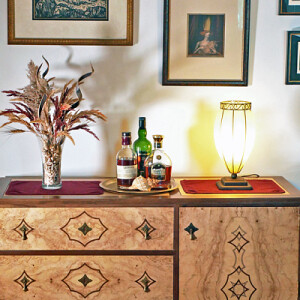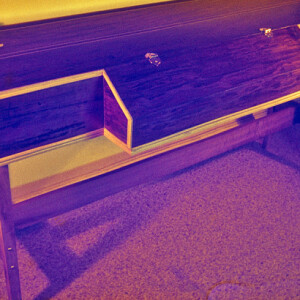A New Sideboard. Voigtlander Color-Skopar 28mm
I have been working on this project for almost exactly two years. Those of you who follow the meanderings of my journal will have seen the slow progress.
Here is a synopsis of the story: Back in 1983, I made a musical instrument called a virginals, a kind of harpsichord. For the casework I used a lovely, dark wood which was readily available back then in South Africa. This wood, Imbuia, was imported from Brazil. Over the intervening decades, Imbuia has been logged practically to the point of extinction. Only small pieces of it, or veneer are now available commercially, at eye-watering prices. Since the value of the wood far exceeded the worth of the virginals as a musical instrument, I decided to cut it up, and use the precious Imbuia, and as much of the internal framing as possible to create an entire new piece of furniture: a credenza or sideboard, in the unique style of antique Cape-Dutch furniture made in South Africa during the 18th and 19th Centuries. The hallmark of this furniture, adapted from Northern European tradition, was the utilization of local lumber resources, combining light and dark wood into a unique and quite dramatic vernacular style. In addition to the Imbuia, I used Mediterranean Cypress for the big floating panels on the sides and top. This was the dregs of a supply I had brought from a lumber yard outside Milan in 2001, meant for making Italian harpsichord cases and soundboards. I also had a small stash of olive-ash burl veneer left over from an earlier project. The curved inlay was sawn out from Imbuia offcuts and assembled into the Arabesque patterns before being inlayed into the burl surfaces on the drawer fronts and closet door. Chest of drawers and closet are two entirely separate structures, designed and built this way to accommodate the limitations of a tiny workshop. The sequence of steps required for final assembly was akin to a 3D puzzle, but it all worked out: two became one. The closet has a pull-out tray of cypress to hold bottles. The first Extra is a "full frontal" to give a better idea of the cabinet in its environment. The second Extra is scanned from my original slide of the just-completed virginals back in 1983
For a fuller version of this tale, here is a link to my Blip from when the project was begun.



Comments
Sign in or get an account to comment.


